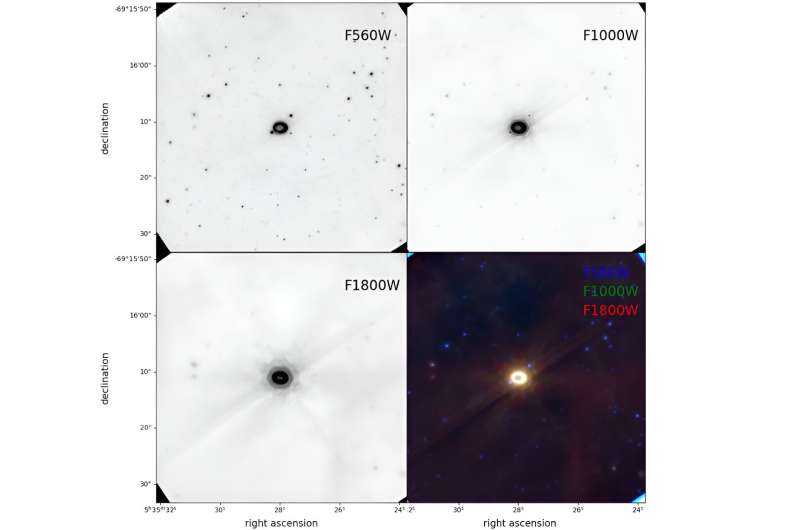February 28, 2024 report
This article has been reviewed according to Science X's editorial process and policies. Editors have highlighted the following attributes while ensuring the content's credibility:
fact-checked
preprint
trusted source
proofread
Supernova SN 1987A investigated with the James Webb Space Telescope

An international team of astronomers has used the James Webb Space Telescope (JWST) to conduct mid-infrared observations of a nearby supernova known as SN 1987A. Results of the observational campaign, published February 21 on the pre-print server arXiv, shed more light on the nature of this supernova.
Supernovae (SNe) are powerful and luminous stellar explosions that could help us better understand the evolution of stars and galaxies. Astronomers divide supernovae into two groups based on their atomic spectra: Type I and Type II. Type I SNe lack hydrogen in their spectra, while those of Type II showcase spectral lines of hydrogen.
SN 1987A, which occurred about 168,000 light years away in the Large Magellanic Cloud (LMC), was first spotted in late February 1987. It was the closest visible supernova in almost 400 years, since Kepler's Supernova, observed in 1604.
Previous studies have found that SN 1987A was a Type II SN that brightened rapidly and reached an apparent magnitude of about 3.0. Due to its proximity, the supernova has been a subject of many observations following its evolution, imaging its process of transformation into a supernova remnant (SNR).
One of the latest observational campaigns of SN 1987A was carried out in mid-2022 by a group of astronomers led by Patrice Bouchet of the Paris-Saclay University in France. They employed JWST's Mid-InfraRed Instrument (MIRI) to explore the morphology and composition of this supernova. It was one of only a few mid-infrared observations of an SN so far performed.
MIRI images obtained by Bouchet's team show the equatorial ring (ER) of SN 1987A, which is bright and 2.0 arcseconds in diameter. Furthermore, an extended nebulosity towards the edges of the field is observed, around a cavity with an angular diameter of some 30 arcseconds that surrounds the supernova.
The data obtained with MIRI allowed the astronomers to construct spatial dust temperature and mass maps for the region encompassing the supernova's ER. The total dust mass was measured to be at a level of 0.000028 solar masses, which is 10 times greater than the mass reported by previous studies.
According to the study, the temperatures in ER are quite non-uniform. It was found that the infrared emission from the east side of the ring is quite a bit fainter at the investigated mid-infrared wavelengths than in the west side. This suggests that the dust has been disrupted in the east region.
The observations also found the infrared emission extends beyond the ER of SN 1987A. This finding may indicate that the shock wave has now passed through the ER to affect the circumstellar medium on a larger scale.
More information: P. Bouchet et al, JWST MIRI Imager Observations of Supernova SN 1987A, arXiv (2024). DOI: 10.48550/arxiv.2402.14014
Journal information: arXiv
© 2024 Science X Network





















